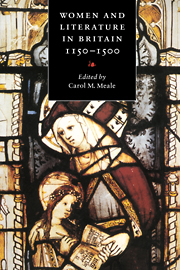Book contents
- Frontmatter
- Contents
- List of illustrations
- List of abbreviations
- Chronology: women and literature in Britain, 1150–1500
- Introduction
- 1 The power and the weakness of women in Anglo-Norman romance
- 2 Women as lovers in early English romance
- 3 Mothers in Middle English romance
- 4 ‘Clerc u lai, muïne u dame’: women and Anglo-Norman hagiography in the twelfth and thirteenth centuries
- 5 Women in No Man's Land: English recluses and the development of vernacular literature in the twelfth and thirteenth centuries
- 6 ‘Women talking about the things of God’: a late medieval sub-culture
- 7 ‘… alle the bokes that I haue of latyn, englisch, and frensch’: laywomen and their books in late medieval England
- 8 Women authors and women's literacy in fourteenth- and fifteenth-century England
- 9 Women and their poetry in medieval Wales
- Further reading
- Index of manuscripts
- Index of names and titles
7 - ‘… alle the bokes that I haue of latyn, englisch, and frensch’: laywomen and their books in late medieval England
Published online by Cambridge University Press: 09 November 2009
- Frontmatter
- Contents
- List of illustrations
- List of abbreviations
- Chronology: women and literature in Britain, 1150–1500
- Introduction
- 1 The power and the weakness of women in Anglo-Norman romance
- 2 Women as lovers in early English romance
- 3 Mothers in Middle English romance
- 4 ‘Clerc u lai, muïne u dame’: women and Anglo-Norman hagiography in the twelfth and thirteenth centuries
- 5 Women in No Man's Land: English recluses and the development of vernacular literature in the twelfth and thirteenth centuries
- 6 ‘Women talking about the things of God’: a late medieval sub-culture
- 7 ‘… alle the bokes that I haue of latyn, englisch, and frensch’: laywomen and their books in late medieval England
- 8 Women authors and women's literacy in fourteenth- and fifteenth-century England
- 9 Women and their poetry in medieval Wales
- Further reading
- Index of manuscripts
- Index of names and titles
Summary
From 1462 until her death in 1478 Margaret, Lady Hungerford and Botreaux, chose a striking image through which to denote her authority. On her seal a woman kneels, surrounded by flowers and foliage. To her right a lion rampant holds a standard bearing the arms of her late husband, while to her left a griffin displays those of her father. A now indistinct scroll encircling the kneeling figure seems to have borne Margaret's motto, ‘Myne trouth assured’ and her head is bowed, as she looks down at the pages of a book open upon her lap (see plate 1). As an image it is richly suggestive, if ambiguous. What is it intended to convey to those who encountered it as a public statement? What is the attitude of the woman towards the book – reverential, or proprietorial? What kind of text is it meant to contain, and in what language?
The posture of the woman recalls contemporary Continental representations of the Virgin of Humility, in which Mary sits or kneels in a garden, surrounded by flowers symbolising her various attributes. The presence of the book is reminiscent of Annunciation scenes in which the Virgin is shown at her devotions, although by the fifteenth century other female saints, such as Mary Magdalene and Barbara, could be depicted in similar positions of humility, again holding, or reading, an open book.
- Type
- Chapter
- Information
- Women and Literature in Britain, 1150–1500 , pp. 128 - 158Publisher: Cambridge University PressPrint publication year: 1993
- 41
- Cited by



